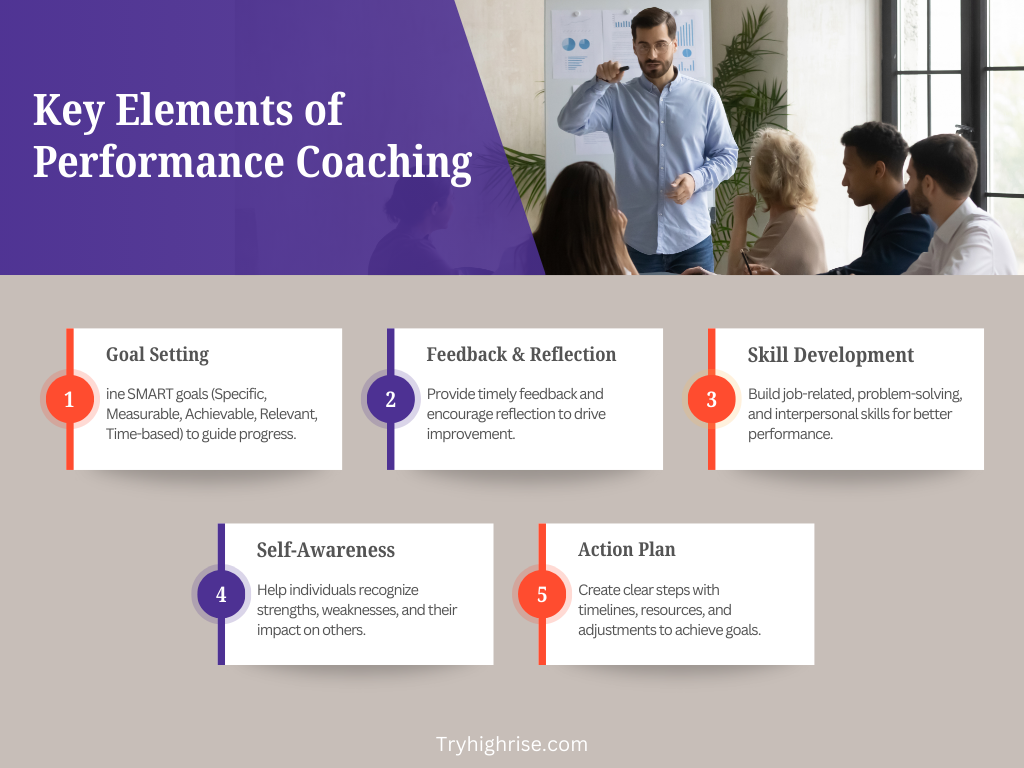<div id ="five">
Performance coaching models.
A successful coaching program relies on the effectiveness of a coaching model. Leaders need to have the right tools to coach well and ensure consistency within the organization.
Here are a few coaching models:
1. The CIGAR model.
This coaching model provides a structure for the coaching process, ensuring that each coaching session is focused and productive.
The model aims to assist individuals in recognizing and addressing the gaps between their current status and desired outcomes.
The CIGAR model is an acronym for Current Reality, Ideal, Gaps, Action, and Review. Let's break them down;
- Current reality refers to an individual's current situation, including strengths and weaknesses. This is the first step of the CIGAR model, where the coach learns what's going on beneath the surface.
- Ideal refers to an individual's desired state based on their aspirations and beliefs. The coach helps coaches visualize their desired outcomes.
- Gaps: refers to the difference between the individual's current reality and ideal state. By identifying the gaps, an individual can develop a plan of action to address the rift. Also, figuring out the gaps between where they currently stand and where they want to be.
- Action entails making a purposeful and conscious effort to achieve the goals. The current role of a coach is to support them by illuminating the path and helping them increase their likelihood of learning more about the process to close the gaps left in their story.
- Review: it involves a comprehensive review of the entire coaching process. At this stage, the coach will monitor performance regularly to gauge whether the performance goals are being achieved.
The CIGAR coaching model is quite effective as a goal attainment and performance tool, and it is enhanced due to the gaps in the analysis between the current situation and the desired state. One has to note that it is indeed possible to have this model come with a review feature, which would be helpful in coaching.
It is important to begin by recognizing that no strategy, no matter how successful, nor any coaching model, no matter how effective, will remain relevant forever. They must be constantly reviewed and developed to sustain and progress further.
2. The FUEL model.
This coaching model is designed for behavioral change within an organization. Many performance coaches prefer the FUEL model because it focuses on the overall growth of an individual. It also helps coaches have structured conversations with their clients.
The FUEL model is based on the premise that all clients have different needs and that these needs can be met by having candid conversations to understand the areas that require improvements.
FUEL coaching model stands for Frame the conversation, Understand the current state, Explore the desired state, and Lay out the success plan.
Frame the conversation.
The coach and coaches converse and agree on the coaching process, purpose, and expectations. This helps identify the performance objectives and performance improvement plan.
Understand the current state.
The coach asks open-ended questions to clarify the current situation. This process helps the employee identify any beliefs that may affect their behavior and offers a perspective on the need for change.
For instance, In what ways are your actions affecting you and those around you?
What do you think is challenging? and How does it impact your goals?
Explore the desired state.
This is where a coach's two-way communication skills are required, in this instance, their active listening skills. A good coach will provide an environment where the client can feel free to share their desired outcomes. Then, both parties can design a vision of success and mutually agree on how to achieve the goal.
Lastly,
Lay out a success plan.
At this stage, a personalized action plan is created to achieve the desired outcomes. The plan must be realistic, achievable, specific, and within a certain time frame. It must also be the coachee's plan, and they should be responsible for it.
The FUEL coaching model is ideal for coaches who want to evaluate and analyze the coachee's situations. It is commonly used in developing high-potential employees, executive coaching, and establishing development action plans. The FUEL coaching model benefits both the coachee and the coach, allowing the coach to practice leadership skills such as motivation, communication, and coaching.
<div id ="six">
Situations where performance coaching is effective.
1. Onboarding new employees.
A performance coach effectively facilitates the integration of new employees into their new jobs because it involves assessing and developing performance needs.
For Example, A new software developer might receive coaching to learn the coding standards and software development practices, ensuring they can contribute effectively to projects within their first few months.
2. Leadership Transitions.
Organizations temporarily remove people from regular work, make them managers, and then coach them to learn how to steer employees and make effective decisions.
For Example, an employee who has recently been transferred to the headship of a specific department may be advised on how best to manage that department, bearing in mind that their previous roles may not have prepared them well enough to head a department.
3. Performance Improvement Plans.
Performance coaching is appropriate when an employee is not effective and needs to be trained on how and what to do to improve performance
4. High-potential employee development.
Coaching as an application assists in developing high-ranking performers in the organization due to information on feedback and learning, focusing on succession management for future leaders.
Example: A high-performing project leader with the potential for an executive role might receive coaching to develop strategic planning skills, improve financial awareness, and gain exposure to cross-functional leadership. This coaching prepares them for a smooth transition into a senior leadership position.



.png)






.png)
.png)
.png)
.png)
.png)
.png)



